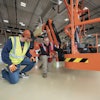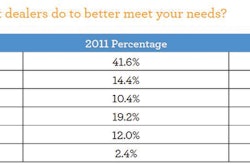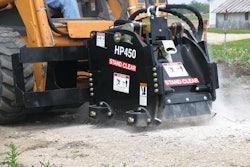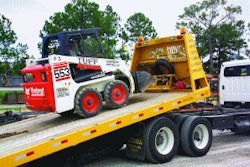Last month, we discussed how to ensure the availability of the equipment you need when you need it. Basically, we recommended you:
1. Make sure equipment is serviced and ready to go, which includes finding a reliable shop for service and parts.
2. Get what you need before the supply runs out, whether that is new or used equipment.
3. Develop a relationship with a local rental house to improve the chances of getting reliable equipment when you need it.
We all know working in today's environment means being efficient, with maximum uptime of equipment on the jobsite. Reducing the risk of downtime increases your chances to maximize profits, which are slim to begin with.
Since last month, I presented the annual CFO Conference for equipment dealer CFOs. We discussed everything from taxes to accounting to banking options, plus had the pleasure of getting Eli Lustgarten, a construction equipment analyst, to help us understand what is going on in the construction equipment arena.
This year, I asked Eli to deal with equipment demand, interest rates, inflation and anything else he wanted to throw into the mix to help CFOs budget the balance of 2011, as well as 2012. What Eli had to say surprised most of us. To answer my questions, he threw out three numbers — 33, 50 and 3 — and let us figure out the rest. After an interesting discussion among the group, Eli revealed what he was talking about and why it is important to you.
Defining the numbers
The number 33 represents the percentage increase in construction equipment sales in 2011. I know we were starting from a depressed historic sales number, but even so, 33% sounds like a lot. Eli responded by saying the equipment manufacturers have sold out their 2011 production runs, and if a dealer or contractor has not placed an order by now, they may have a hard time finding what they need.
Rental companies and contractors are buying to replace worn-out units because interest rates are still low; the 100% tax benefits are available for equipment placed in service by December 31, 2011; and because 2012 models are unlikely to have the tax benefits attached to them, plus will be more expensive. I guess you know how this scenario will affect the cost of used equipment.
The number 50 represents the 50 basis point, or 1/2%, increase in the prime interest rate Eli expects sometime this year. This is still workable, with a minimum affect on profits or cash flow.
The number 3 relates to the inflation factor you should consider when projecting your General and Administrative (G&A) expenses for the next 12 months. In short, for budgeting purposes, expect your G&A expenses to increase 3% for expenses you can't do anything about. Unfortunately, this 3% will come out of your hide because profit margins are so competitive.
That said, the 3% has nothing to do with labor or material costs associated with your work. Union costs, health care costs, material costs and now your equipment costs are all sure to increase beyond that 3% number.
Equipment availability is tight and getting tighter
As I have mentioned previously, I also work in the equipment rental industry and am now seeing firsthand how the issues Eli brought up are hitting the marketplace.
Requests to buy new equipment are off the wall. By May 31st, we exceeded our new equipment sales budget for the year and the calls keep coming in. Right now, we are telling customers we can place the order, but are not sure they will get the equipment in to do much work in 2011.
Used equipment prices are going up every month and we keep getting requests to sell our rental fleet. The market is tight for good used equipment.
Requests for parts and shop work have also increased to the point where we have to decide how much we can take on and still properly maintain the rental fleet.
Rental demand has been crazy and current rates are going to reflect that. If you think you're going to pay the same rental rates you did the last two years, that is not going to happen. If you find a cheap rate, you may want to check out the unit before they bring it out. It may not be in very good shape.
I believe the comments from the conference and my personal experience in renting equipment in a Midwest City support what I said last month: the equipment market is changing. It is tightening up, making availability tougher while pushing your costs higher. This is something to consider when bidding future work.
Can you overcome these obstacles and continue to work without equipment problems? Sure you can — if you can offer up a payment plan to the dealer or rental company that gets them paid without any hassle. We had a unit two customers were considering; one of the customers stepped up to the plate with his credit card. Guess who got the unit?
You may want to consider doing something similar, or a variation thereof. For example, you could offer up a credit card 30 days after the invoice date. Or maybe you could pay for the first rental up front to establish credit, and then 45 days after invoicing for the second invoice after that.
Your equipment costs are going up whether you buy new, used or rent. Don't forget to take these cost increases into account when bidding future work. And don't forget to make friends with the folks who help keep the equipment working and available.


















